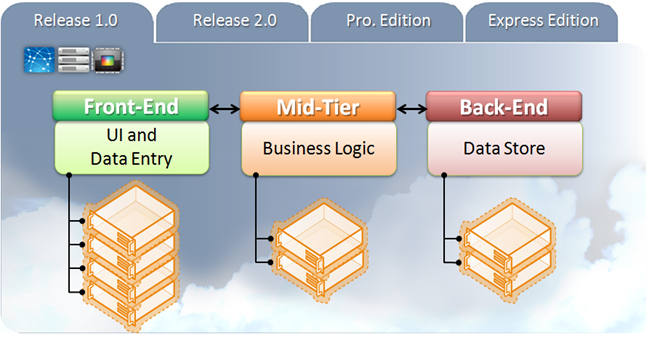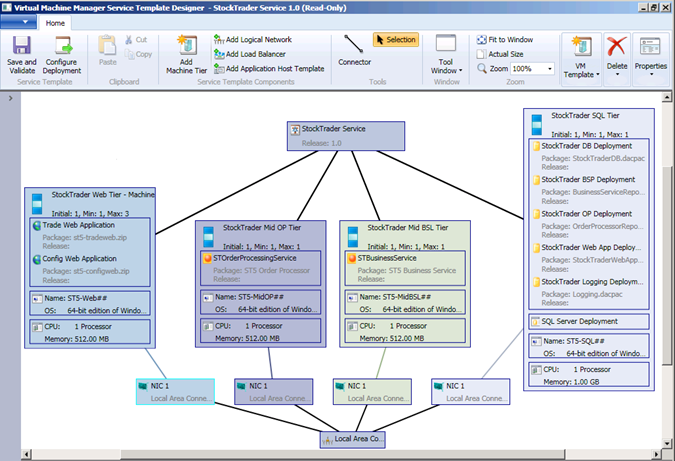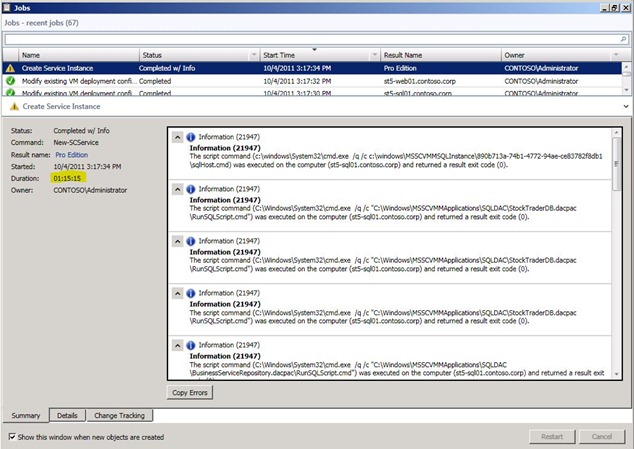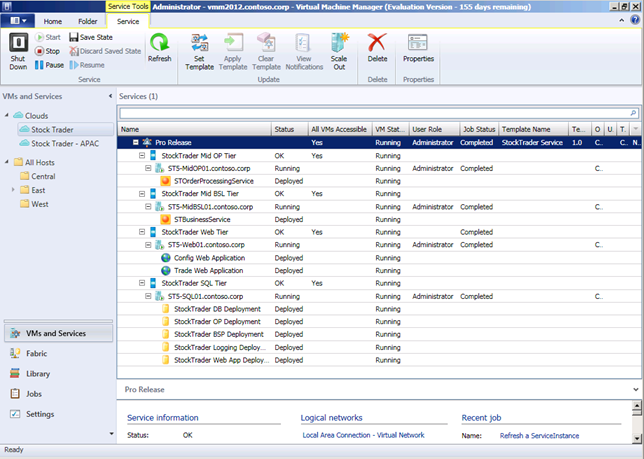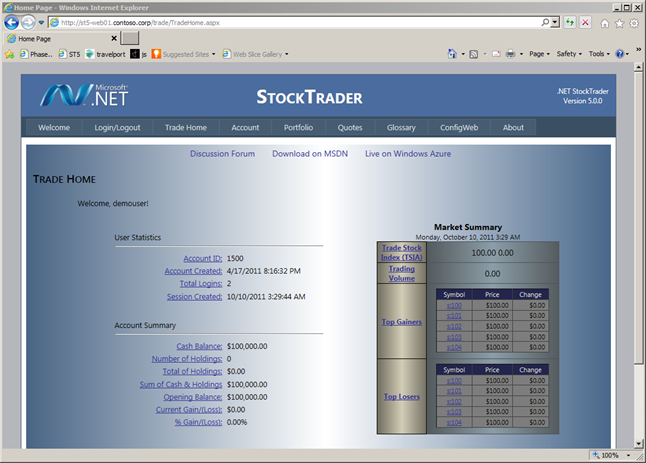System Center Virtual Machine Manager (VMM) 2012 as Private Cloud Enabler (3/5): Deployment with Service Template
By this time, I assume we all have some clarity that virtualization is not cloud. There are indeed many and significant differences between the two. A main departure is the approaches of deploying apps. In the 3rd article of the 5-part series as listed below, I would like to examine service-based deployment introduced in VMM 2012 for building a private cloud.
- Part 1. Private Cloud Concepts
- Part 2. Fabric, Oh, Fabric
- Part 3. Deployment with Service Template (This article)
- Part 4. Working with Service Templates
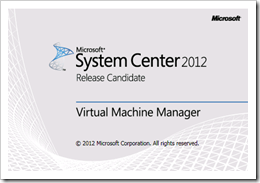
- Part 5. App Controller
VMM 2012 has the abilities to carry out both traditional virtual machine (VM)-centric and emerging service-based deployments. The formal is virtualization-focused and operated at a VM level, while the latter is service-centric approach and intended for private cloud deployment.
This article is intended for those with some experience administering VMM 2008 R2 infrastructure. And notice in cloud computing, “service” is a critical and must-understand concept which I have discussed elsewhere. And just to be clear, in the context of cloud computing, a “service” and an “application” means the same thing, since in cloud everything to user is delivered as a service, for example SaaS, PaaS, and IaaS. Throughout this article, I use the terms, service and application, interchangeably.
VM-Centric Deployment
In virtualization, deploying a server has becomes conceptually shipping/building and booting from a (VHD) file. Those who would like to refresh their knowledge of virtualization are invited to review the 20-Part Webcast Series on Microsoft Virtualization Solutions.
Virtualization has brought many opportunities for IT to improve processes and operations. With system management software such as System Center Virtual Machine Manager 2008 R2 or VMM 2008 R2, we can deploy VMs and installs OS to a target environment with few or no operator interventions. And from an application point of view, with or without automation the associated VMs are essentially deployed and configured individually.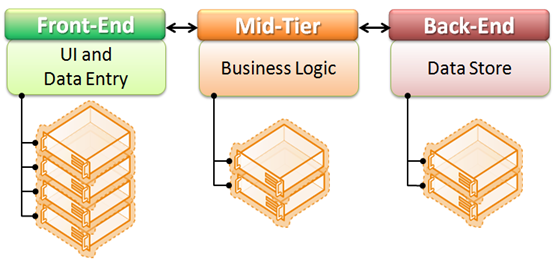 For instance, a multi-tier web application like the one shown above is typically deployed with a pre-determined number of VMs, followed by installing and configuring application among the deployed VMs individually based on application requirements. Particularly when there is a back-end database involved, a system administrator typically must follow a particular sequence to first bring a target database server instance on line by configuring specific login accounts with specific db roles, securing specific ports, and registering in AD before proceeding with subsequent deployment steps. These operator interventions are required likely due to lack of a cost-effective, systematic, and automatic way for streamlining and managing the concurrent and event-driven inter-VM dependencies which become relevant at various moments during an application deployment.
For instance, a multi-tier web application like the one shown above is typically deployed with a pre-determined number of VMs, followed by installing and configuring application among the deployed VMs individually based on application requirements. Particularly when there is a back-end database involved, a system administrator typically must follow a particular sequence to first bring a target database server instance on line by configuring specific login accounts with specific db roles, securing specific ports, and registering in AD before proceeding with subsequent deployment steps. These operator interventions are required likely due to lack of a cost-effective, systematic, and automatic way for streamlining and managing the concurrent and event-driven inter-VM dependencies which become relevant at various moments during an application deployment.
Despite there may be a system management infrastructure in place like VMM 2008 R2 integrated with other System Center members, at an operational level VMs are largely managed and maintained individually in a VM-centric deployment model. And perhaps more significantly, in a VM-centric deployment too often it is labor-intensive and with relatively high TCO to deploy a multi-tier application “on demand” (in other words, as a service) and deploy multiple times, run multiple releases concurrently in the same IT environment, if it is technically feasible at all. Now in VMM 2012, the ability to deploy services on demand, deploy multiple times, run multiple releases concurrently in the same environment become noticeably straightforward and amazing simple with a service-based deployment model.
Service-Based Deployment
In a VM-centric model, there lacks an effective way to address event-driven and inter-VMs dependencies during a deployment, nor there is a concept of fabric which is an essential abstraction of cloud computing. 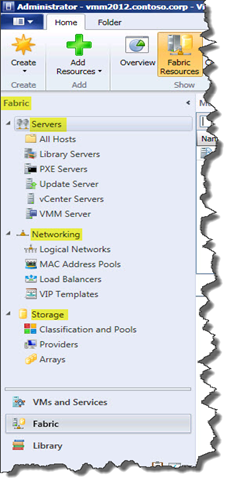 In VMM 2012, a service-based deployment means all the resources encompassing an application, i.e. the configurations, installations, instances, dependencies, etc. are deployed and managed as one entity with fabric . The integration of fabric in VMM 2012 is a key delivery and clearly illustrated in VMM 2012 admin console as shown on the left. And the precondition for deploying services to a private cloud is all about first laying out the private cloud fabric.
In VMM 2012, a service-based deployment means all the resources encompassing an application, i.e. the configurations, installations, instances, dependencies, etc. are deployed and managed as one entity with fabric . The integration of fabric in VMM 2012 is a key delivery and clearly illustrated in VMM 2012 admin console as shown on the left. And the precondition for deploying services to a private cloud is all about first laying out the private cloud fabric.
Constructing Fabric
To deploy a service, the process normally employs administrator and service accounts to carry out the tasks of installing and configuring infrastructure and application on servers, networking, and storage based on application requirements. Here servers collectively act as a compute engine to provide a target runtime environment for executing code. Networking is to interconnect all relevant application resources and peripherals to support all management and communications need, while the storage is where code and data actually resides and maintained. In VMM 2012, the servers, networking, and storage infrastructure components are collectively managed with a single concept as private cloud fabric .
There are three resource pools/nodes encompassing fabric: Servers, Networking, and Storage. Servers contain various types of servers including virtualization host groups, PXE, Update (i.e. WSUS) and other servers. Host groups are container to logically group servers with virtualization hosting capabilities and ultimately represent the physical boxes where VMs can be possibly deployed to, either with specific network settings or dynamically selected by VMM Intelligent Placement, as applicable, based on defined criteria. VMM 2012 can manage Hyper-V based, VMware, as well as other virtualization solutions. During adding a host into a host group, VMM 2012 installs an agent on a target host which then becomes a managed resource of the fabric.
A Library Server is a repository where the resources for deploying services and VMs are available via network shares. As a Library Server is added into fabric, by specifying the network shares defined in the Library Server, file-based resources like VM templates, VHDs, iso images, service templates, scripts, server app-v packages, etc. are become available and to be used as building blocks for composing VM and service templates. As various types of servers are brought in the Server pool, the coverage expanded and capabilities increased as if additional fibers are weaved into fabric.
Networking presents the wiring among resources repositories, running instances, deployed clouds and VMs, and the intelligence for managing and maintaining the fabric. It essentially forms the nervous system to filter noises, isolate traffic, and establish interconnectivity among VMs based on how Logical Networks and Network Sites are put in place.
Storage reveals the underlying storage complexities and how storage is virtualized. In VMM 2012, a cloud administrator can discover, classify and provision remote storage on supported storage arrays through the VMM 2012 console. VMM 2012 fully automates the assignment of storage to a Hyper-V host or Hyper-V host cluster, and tracks the storage that is managed by VMM 2012.
Deploying Private Cloud
A leading feature of VMM 2012 is the ability to deploy a private cloud, or more specifically to deploy a service to a private cloud. The focus of this article is to depict the operational aspects of deploying a private cloud with the assumption that an intended application has been well tested, signed off, and sealed for deployment. And the application resources including code, service template, scripts, server app-v packages, etc. are packaged and provided to a cloud administrator for deployment. In essence, this package has all the intelligence, settings, and contents needed to be deployed as a service. This self-contained package can then be easily deployed on demand by validating instance-dependent global variables and repeating the deployment tasks on a target cloud. The following illustrated the concept where a service is deployed in update releases and various editions with specific feature compositions, while all running concurrently in VMM 2012 fabric. Not only this is relative easy to do by streamlining and automating all deployment tasks with a service template, the service template can also be configured and deploy to different private clouds.
The secret sauce is a service template which includes all the where, what, how, and when of deploying all the resources of an intended application as a service. It should be apparent that the skill sets and amount of efforts to develop a solid service template apparently are not trivial. Because a service template not only needs to include the intimate knowledge of an application, but the best practices of Windows deployment in addition to system and network administrations, server app-v, and system management of Windows servers and workloads. The following is a sample service template of StockTrader imported into VMM 2012 and viewed with Designer where StockTrader is a sample application for cloud deployment downloaded from Windows Connect.
Here are the logical steps I follow to deploy StockTrader with VMM 2012 admin console:
- Step 1: Acquire the Stock Trader application package from Windows Connect.
- Step 2: Extract and place the package in a designated network share of a target Library Server of VMM 2012 and refresh the Library share. By default, the refresh cycle of a Library Server is every 60 minutes. To make the newly added resources immediately available, refreshing an intended Library share will validate and re-index the resources in added network shares.
- Step 3: Import the service templates of Stock Trader and follow the step-by-step guide to remap the application resources.
- Step 4: Identify/create a target cloud with VMM 2012 admin console.
- Step 5: Open Designer to validate the VM templates included in the service template. Make sure SQLAdminRAA is correctly defined as RunAs account.
- Step 6: Configure deployment of the service template and validate global variables in specialization page.
- Step 7: Deploy Stock Trader to a target cloud and monitor the progress in Job panel.
- Step 8: Troubleshoot the deployment process, as needed, restart the deployment job, and repeat the step as needed
- Step 9: Upon successful deployment of the service, test the service and verify the results.
A successful deployment of Stock Trader with minimal instances in my all-in-one-laptop demo environment (running in Lenovo W510 with sufficient RAM) took about 75 to 90 minutes as reported in Job Summary shown below.
Once the service template is successfully deployed, Stock Trader becomes a service in the target private cloud supported by VMM 2012 fabric. The following two screen captures show a Pro Release of Stock Trader deployed to a private cloud in VMM 2012 and the user experience of accessing a trader’s home page.
Not If, But When
Witnessing the way the IT industry has been progressing, I envision that private cloud will soon become, just like virtualization, a core IT competency and no longer a specialty. While private cloud is still a topic that is being actively debated and shaped, the upcoming release of VMM 2012 just in time presents a methodical approach for constructing private cloud based on a service-based deployment with fabric. It is a high-speed train and the next logical step for enterprise to accelerate private cloud adoption.
Closing Thoughts
I here forecast the future is mostly cloudy with scattered showers. In the long run, I see a clear cloudy day coming.
Be ambitious and opportunistic is what I will encourage everyone. When it comes to Microsoft private cloud, the essentials are Windows Server 2008 R2 SP1 with Hyper-V and VMM 2012. And those who first master these skills will stand out, become the next private cloud subject matter experts, and lead the IT pro communities. While recognizing private cloud adoption is not a technology issue, but a culture shift and an opportunity of career progression, IT pros must make a first move.
In an upcoming series of articles tentatively titled “Deploying StockTrader as Service to Private Cloud with VMM 2012,” I will walk through the operations of the above steps and detail the process of deploying a service template to a private cloud.
